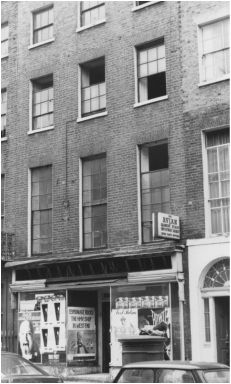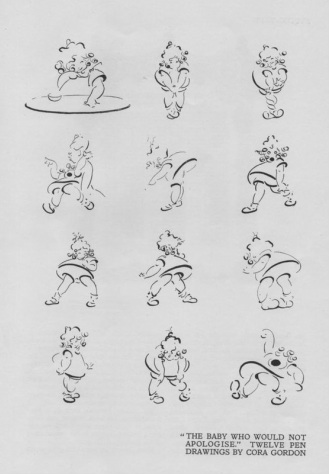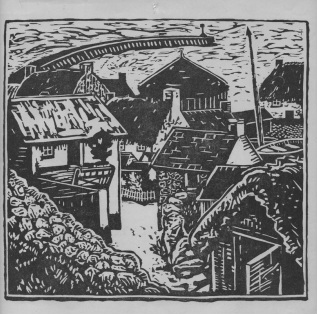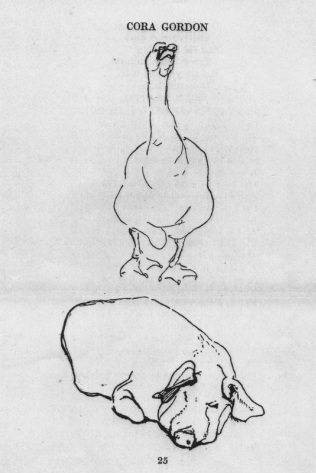 from 1916 they lived in the top flat at 54 Grafton street; shown here in the 1980s I was able to gain access for a look around, just as it was being gutted. It now forms part of Venezuelan cultural centre.
Semi derelict for decades it was quite eerie to walk the bare boards.
from 1916 they lived in the top flat at 54 Grafton street; shown here in the 1980s I was able to gain access for a look around, just as it was being gutted. It now forms part of Venezuelan cultural centre.
Semi derelict for decades it was quite eerie to walk the bare boards.
Life in London 1916
Now safely back in London their pressing problem was what to do next---, naturally they would have chosen to return to Paris where all their work and possessions remained in the Rue Bagneaux studios which they had not long lived in.
That was now out of the question with the escalating War situation. On the other hand being of the first Red Cross units from the Serbian collapse they were in possession of something of a journalistic scoop.
Cash income was an urgent need so they wrote a piece for the London Times and had several other pieces accepted for the Westminster Gazette and New Witness. The Illustrated London News carried in its Dec 25 1915 issue, a double page illustration worked up from a Jan Gordon sketch by the resident ILN illustrator, Fredric de Haenen.
A truly poignant view of the misery of the Serbian retreat.
Cecil Chesterton, younger brother of the illustrious GK, suggested that they write a book of their adventures and suggested publisher Chapman and Hall as a likely publisher.
Jan’s quirky memory, which seems to almost have amounted to a kind of proper name dyslexia led then to the offices of Smith Elder instead.
A bemused publisher listened to them with interest and the book proposal was accepted with the proviso it was to be in print as soon as possible. Jan and Cora set to work to complete the book in a fortnight------ they divided their copious diaries into 24 parts and each wrote alternate chapters, then each would proof read and correct the others draft chapter.
The copy was sent daily to the printer to be typeset and was finished in a fortnight; no mean feat indeed.
The ‘Luck of Thirteen’ was off the press and in the bookshops within weeks and the ‘Balkan Freebooter’ was hot on its heels.
The books were favourably reviewed in a number of newspapers, Serbian and the events there being to the forefront of the news then. Only an opportunistic politician found fault with it, naturally without eve reading anything other than précised news clippings, and wrote an indignant letter to the Times condemning Jan and Cora’s “levity” in their account of their adventures.1
Jan, convalescing in Ireland, was late in responding, but Walter Lyon Blease, [later to be come a Liberal MP etc] was also on the retreat with them sprang to Jan’s defence in no uncertain terms to put the record quite straight.
This effort to denigrate them did evidently rankle with Jan, as he referred it obliquely in the preface to the amended 1939 Penguin version, ‘Two Vagabonds in Serbia’.
Initially they took rooms in 5 Robert St NW1 London, which set of lodgings was used as a setting for part of the narrative in ‘Buddock against London’ Jan’s first published novel.
A little while later they moved to the top flat of 54 Grafton St, (now Grafton Way) which road joins Tottenham court road to Fitzroy Square en route via Charlotte St to the restaurants of Soho, the nearest equivalent one could get to the artistic society of Paris. Almost opposite at No 41 they had for company Nina Hamnett, by then married to and living with the curious and elusive Roald Kristian.
It is not clear how Jan came to be recruited into civilian war work but doubtless his engineering aptitude played a part and he was in intensive training to be a machine grinder at Buck and Hickman engineering works in Whitechapel, East London.
Training finished, in early 1917 he was informed he was to be transferred to The Rolls Royce Factory in Derby to be employed in the manufacture of aeroplane engine parts.
He was billeted within walking distance of the works in a private house known only as ‘Norton Villas’. He opted for the permanent night shift after working out that judicious juggling of his free time would enable him to snatch regular long weekends away in London with Cora. They had never been parted for such long periods since they married in 1909.
Cora meanwhile occupied herself with doing the rounds of the London Art shows and galleries, of which she would write a resume and send it to Jan to expand into the regular Art commentary he had contracted to write in the New Witness, they having become good friends of JK Prothero the editress of the New Witness and partner of Cecil Chesterton.
Evidence from Jan’s diary shows that he had given up painting for writing, “at the outbreak of war he felt unable to paint” In his free time at Norton villas Jan wrote copiously, both regular and occasional columns for the New Witness, but also for ‘Land and Water’ and the ‘Nation’. He worked also on his novel (s) ‘Buddock against London’ and ‘Piping George’ it is not clear which was the predominate work. His ‘Modern French Painters’ was also in the process of development.
The tightly and minutely written 1917 diaries which held out so much promise of insight into their life and work mostly only reveal Jan’s intense frustration at the limitations of the work--- the interminable boredom relieved only by the occasional comic incident or the eternal petty machinations and quarrels of the work force and management at the works.
It was filthy work. The winter was harsh and Jan’s endemic bronchial problems (those same that along with his short sight had kept him from the trenches) were exacerbated by the fine metal dust and lubricant spray associated with the grinding process, and of course exacerbated by his incessant tobacco smoking habit.
It must have been so dreadfully cramping to a man of artistic disposition used to an informal and liberal lifestyle in peacetime Paris.
Try as he might, Jan never managed to strike up the intimacy with his fellow workers he would have liked--- his educated accent, his background from what Jan would always refer to as the “gentleman class”, a strata of British society now defunct erected an invisible barrier, the skilled men’s attitude towards these hastily trained and semi-skilled workmen would also have been an issue.
The factory rumour service discovered that he was the author of ‘Luck of Thirteen’ and about his Red Cross service in The Balkans, with the result that the ill informed workforce nicknamed him ‘The Russian’—He describes his clumsy efforts to interest the working men in the workshops to take an interest in things outside their usual round of work, beer, billiards and attempts to seduce the female workforce in between the eternal squabbling over bonus or overtime payments.
The labour force at Rolls Royce in the 1914-18 years seems to have been remarkably discontent; Jan observed their problems and wrote about them in the weekly political paper “The Nation”, which earned him a degree of respect in the workshops. Jan had a leaning towards Fabian Socialism, and was convinced that the end of the war would bring about revolution in England. It becomes apparent in retrospective reading of his notes that this soon evolved into a weary resignation that… plus ça change plus ça la meme chose, and that while Jan would join in heartily to such discussion, he had given up on the idea.
About every alternate Friday he managed to take the train to London where he would immerse himself, often sleepless, in the small ‘Bohemian’ circle they frequented between the ‘Swiss’ Restaurant in Charlotte street, The ‘Tour Eiffel’, the Café Royal and a number of arty Bohemian style clubs, -- the ‘Studio club’, the ‘Senefelder club’. ‘The Poets Society’ and later the ‘Savage Club’.
Such names that are recorded in passing in the diaries merely serve to inflame my frustration at the paucity of the record------ names such as Middleton Murray, Katherine Mansfield, Nina Hamnett, Ezra Pound, Dolmetsch, Epstein, and Chesterton are amongst many others only identified by initial or blank space to annoy frustrate and beleaguer the biographer; a few rose to a modest fame in their time only to relapse into obscurity with death and time- Robert Steele, JWN Sullivan, Claude Houghton, Dan Rider. Now ought but names in a card index somewhere.
The first diary ends abruptly on an August Bank holiday 1916 at Itchenor, Sussex; just as Jan is beginning to relax and record some tantalising gossip.
Sometime shortly after this, about November 1917, Jan was recruited, with others, to work under Norman Wilkinson at the Royal Academy, London, where, housed in the basement was the newly formed and secret department working on the development of the new Dazzle camouflage invented by Norman Wilkinson which was to be such an effective method of diminishing the horrendous toll being taken on Atlantic convoys by German submarines.
This project, for which Jan was given the rank and pay of Lieutenant RNVR finally put Jan into uniform, and thus back in London and reunited with Cora.
Dazzle camouflage had been invented in May 1917 by Norman Wilkinson—initial trials approved so outstandingly successful that the first ship, HMS Industry, had been painted trialled and the necessary staff assembled to expand the scheme to be well under way by autumn 1917. Jan must therefore have been amongst the very first artists to be recruited to this crucial venture.
To escape from the stifling atmosphere of the Derby Works and return to London must have been a real relief to Jan, more so as the Zeppelin air raids on London were becoming ever more regular, and Cora, true to form would not take cover but insisted in going up onto the roof of the attic flat in Grafton street to watch the anti aircraft action and the reactions in the streets.
The Dazzle Camouflage unit was run from rooms in the basement of the Royal Academy, Piccadilly------- a team of Artists designed colour schemes within the parameters laid down by Wilkinson; irregular blocks of colour for each type of ship.
These were then applied to model ships and the effect observed and assessed via a periscope against a series of painted seascape backgrounds, and then these were transferred to scaled paper plans by a team of women draughtsmen.
The periscope was important, as the idea of the camouflage was not to hide the vessel, but to deceive the captain of an enemy submarine as to the course, type, and speed of a sighted ship as seen from a submarine periscope at near sea level.
It proved to be remarkably successful and Jan revelled in the work finding in it an outlet for his war repressed creativity and again I have no doubt his engineering background would have been invaluable.
Jan records that he threw himself into this work, often producing several times more designs than some of the others.
Being resident within walking distance of what was to become Fitzrovia enabled them to again renew their circle of artistic friends, but again the copiously filled diary is lacking in the identities of the circle among whom they moved. By the end of the last diary Jan is posted for a few weeks to a ship anchored in the Mersey estuary in order to observe Dazzle ships at sea and an entry herein ends abruptly in mid sentence, never to be resumed in that volume.
The record is so far blank until 1919, Jan continued to paint and write for the New Witness, and others but in March 1919 the then editor John Middleton-Murray took him on as art critic for the Athenaeum.
The evidence for this come from a bitchy letter written by the arch Bloomsbury-ite Virginia Woolf who wrote
“ …Murray has got a man called John (sic)Gordon, a very bad painter he says, to do art criticism; but I suggested he’d much better get Duncan (Grant) to do the important things at any rate….”
It would seem that the spiteful Virginia Woolf had been somewhat upset by either Jan or Cora at some time; after all they lived only a few yards away from the Bloomsbury Omega workshops in Fitzroy Square and Jan had been quite scathing about some of the work pushed out from there, although he would always find words to support Nina Hamnett, for whom he retained an amicable affection.
He described an Omega dress worn by Nina as “…looking like it had been assembled from a collection of old dusters…” ; having seen a picture of this dress it I can agree with Jan, I expect he was just as forthright in the presence of any of the Bloomsbury set, which had established itself as a powerful clique within the Athenaeum, as soon as Murry took the editors chair, and who lost no time in filling the paper with his Bloomsbury cronies.
Jan did not last long amongst this back stabbing clique, he gives no hint of animosity between himself and Murray in the odd diary entries that mention Murry. Yet in a matter of months, 21 October 1919 Murray was writing to Katherine Mansfield
“ …..today I wrote to Gordon sacking him as art critic. It was jolly hard to do and I hated it.But I’m sure it was right for the paper.His writing hasn’t improved an inch since he began;and its wrong of me to sit down and re-write his copy every week. More important still, I think he’s always wrong in his judgements………….. he sent up a sentence today on Nina Hamnett today that was the last straw, and I wrote giving him his congé there and then, He should have taken his work more seriously………..”
One can only wonder why, if Murray had wanted his own opinions about art boosted in his paper that he did not write them himself .
It seems to me that what Murray had in mind was the boosting of the pretentious output of that same incestuous clique he had installed at the Athenaeum.
And to further irritate Virginia, the post Jan vacated was filled, not by her favoured Duncan Grant, but by RH Wilenski, who had studied at Kensington with Jan and Nina, (somewhere a photograph exists of them all together at Brangwyns) but Wilenski had failed to make his mark as a painter and had turned to criticism and art history.
Jan's last book was a not at all serious book of doggerel poetry about art history, in collaboration with Clive Bell. I can only surmise that the mentally unbalanced Virginia Woolf held a grudge against Jan to the end of her life. In May 1937 she visited Najac and set about venting her spleen on that innocent village.
Using Medieval as a term of abuse she sneered in her usual way at the village commenting that it was empty, failing as ever to realise that the inhabitants were going about their daily grind and not sitting about to be patronised or dance attendance on her.
It amuses me to speculate that the ongoing success of this “bad painter” had riled her somewhat, certainly ‘Two Vagabonds in Languedoc’ was doing far better than any of her own writing; by then it had gone into two editions, an American edition, and a cheaper edition as ‘Two Vagabonds in a French Village’ to say nothing of the ongoing popularity of the rest of their books.
Sadly Jan and Cora did not possess that air of arrogant self importance that would lead them to compile and conserve the endless tedious laundry lists such as the Bloomsbury clique have done.
But I doubt that Jan was overly upset by this hiccup as by late 1919,( he was demobilised on 1.12.1919) they must have been planning a return to Paris and their first trip to Spain.
Moreover Jan went straight to the rival weekly New Age, where he wrote longer articles under his own name, for an editor, A R Orage of whom it was written...
“He expected his contributors to be competent, honest and accurate: but beyond that he did not care what they wrote”
…unlike Middleton Murray who to suit his own opinions evidently rewrote Jan’s copy.
For the ‘New Age’ Jan wrote a series of articles featuring his thoughts on aesthetics and of how machines have altered our perception of art.
The drawback was that by this time 1919 the New Age had a very limited circle of readers and contributors, being written for the most part by Ezra Pound, Beatrice Hastings and Orage under a long list of pseudonyms.
Ezra Pound, in his normal elaborate and eccentric prose did though favourably view Jan's works as exhibited at the end of 1919 by the Imperial War museum at the Royal Academy. Pound had met Jan and Cora some months before at the home of Jack Yeats.
Jan must also have been in contact with Beatrice Hastings who had been a long term lover and punch bag of Modigliani.
.It is also tempting to speculate if Beatrice had any input to Jan’s opinion of Modigliani for who Jan wrote an obit appreciation for Land and Water Feb 12 1920, another magazine for which Jan was a regular contributor on art matters.
He had been writing for Land and Water since at least 1918 at which time it published what must be the first public explanation of the thinking behind the concept of Dazzle camouflage by Jan.
I am certain that both Jan and Cora must have met Modigliani in Paris either at Colorossi’s academy, in the area around carrefour Vavin , or via Beatrice Hastings; sadly no contact has been recorded anywhere so it must remain only my speculation.
Both Jan and Cora were beginning to be noticed in the various little reviews and magazines of the period, Cora had work reproduced in ‘The Studio’,Sept 15 1919; (The baby who would not apologise); ‘Coterie’, No 2 ( pen drawing of a sleeping pig and a goose) and ‘The Apple of Beauty and Discord,’ while Jan had had one of his early etchings printed as a half page illustration and praised in the Studio 1912. Oct 15 1912 (The Tipsy Dwarf) the first picture shown on the page Art of Jan Gordon.
1 [to be added]


